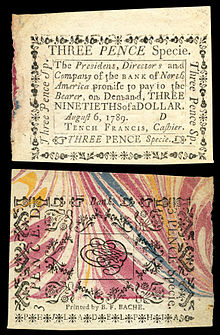Bank of North America
In May 1781, Alexander Hamilton revealed that he had recommended Robert Morris for the position of Superintendent of Finance of the United States the previous summer when the constitution of the Articles of Confederation-era executive was being solidified.
[9] Benjamin Franklin purchased a single token share as a sign of good faith to Federalists and their new bank.
Hamilton used his pseudonym "Publius", later immortalized in the Federalist Papers advocating in the late 1780s for adoption of the United States Constitution, to endorse the bank.
[13] Thomas Willing, who served two terms as mayor of Philadelphia and was a partner with Morris in an import-export firm that once dominated the city's slave trade,[14] was named the bank's first president.
To promote the impression that it had a large reserve, the bank made a show of moving cash boxes to and from its cellar.
[2] By 1783, several states including Massachusetts enacted legislation allowing Americans to pay taxes with Bank of North America notes,[17] giving them a crucial aspect of legal tender.
The following year, the Pennsylvania General Assembly granted a new charter with several restrictions, including that it could not trade any merchandise other than bullion.

